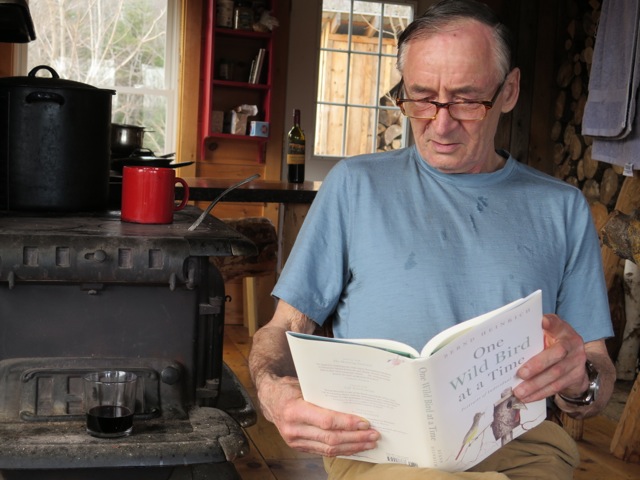"In One Wild Bird at a Time, Heinrich returns to his great love: close, day-to-day observations of individual wild birds. There are countless books on bird behavior, but Heinrich argues that some of the most amazing bird behaviors fall below the radar of what most birds do in aggregate. Heinrich’s “passionate observations [that] superbly mix memoir and science” (New York Times Book Review) lead to fascinating questions — and sometimes startling discoveries. A great crested flycatcher, while bringing food to the young in their nest, is attacked by the other flycatcher nearby. Why? A pair of Northern flickers hammering their nest-hole into the side of Heinrich’s cabin deliver the opportunity to observe the feeding competition between siblings, and to make a related discovery about nest-cleaning. One of a clutch of redstart warbler babies fledges out of the nest from twenty feet above the ground, and lands on the grass below. It can’t fly. What will happen next?"
Quote: "Each animal gives us a new view, a new experience, that involves stepping out of our own world into another, and it is always an adventure."
(http://cdn.phys.org/newman/gfx/news/2016/peeringintot.jpg)
Reviews:
Kirkus Review: https://www.kirkusreviews.com/book-reviews/bernd-heinrich/one-wild-bird-at-a-time/
WSJ: "Minding the Nest": http://www.wsj.com/articles/minding-the-nest-1463164185
The Naturalist's Notebook: The story behind the book, written by Heinrich:
http://www.thenaturalistsnotebook.com/one-wild-bird-at-a-time/
Interviews:
Q & A with the Author:http://www.thenaturalistsnotebook.com/our-blog/q-and-a-with-bernd-heinrich-about-his-new-book-one-wild-bird-at-a-time
Other books by Bernd Heinrich: Winter World, Summer World, One Man's Owl, Mind of the Raven, Why We Run, The Trees in my Forest, Life Everlasting
Discussion Questions:
1. Do you bird watch? If yes, Where? When? What?
2. Have you ever participated in a bird walk or birding
class?
3. Which bird species, presented in this book, are familiar
ones to you? New ones?
4. Bernd presents chapter after chapter of amazing
observations, confirmations of old findings and makes new exciting discoveries.
What are some of his observations of birds that surprised you?
5. Have you observed or witnessed yourself, some of the
findings that Bernd presents here in this book, such as mobbing, courting, communication,
nesting behaviors, sharing, survival strategies, snow diving or denning, flock
learning, mourning, etc.?
6. Bernd intervenes, even interferes with several birds' lives,
such as with Pipsqueak, “So, I went to
find him, extracted him from the thicket and carried him to the cabin . . .”
(p. 14-15) or with Slick, “On his next
landing I closed my fingers, trying to grab him by his legs, and managed to
snag him by a toe.” (p. 28). What
are your thoughts about this? Have you ever stepped in to help a bird or animal
yourself?
7. Bernd uses a bird feeder and provides seeds for the birds
in his area. “Nowadays the chickadees
often seem to live on black sunflower seeds. A crowd of them at my bird feeder
in Vermont had consumed over a hundred pounds of the seeds per winter . . .”
(p. 108) Do you use a bird feeder? How often and how much do you feed them? Do you use specific kinds of seeds to attract
certain species?
8. In considering Pough’s statement , “If enough winter bird-feeding stations are established to free the
evening grosbeak from dependence on natural foods its population might increase
greatly in years to come.” (p. 178) What are your thoughts regarding using
a bird feeder? What are the pros and cons?
9. Bernd’s writing is very fluid and accessible. Do you
track your own observations of birds and animals you see? If yes, feel free to
bring your journal along to share. What have you seen, that bewildered or
excited you?
Bernd Heinrich in his cabin in Maine.
Photo from Naturalist Notebook.


